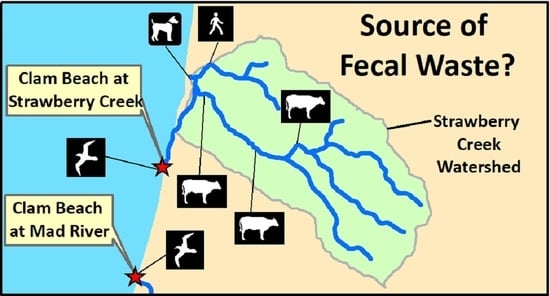Microbial Source Tracking Approach to Investigate Fecal Waste at the Strawberry Creek Watershed and Clam Beach, California, USA
Abstract
:1. Introduction
2. Materials and Methods
2.1. Study Location and Watershed Sanitary Survey
2.2. Beach and Watershed Study Collection
2.3. FIB Analysis
2.4. MST Sample Preparation
2.5. QPCR Analysis of MST Markers
2.6. Statistical Methods
2.7. Regulatory Standards Evaluated
- (1)
- 10,000 total coliform bacteria per 100 milliliters; or
- (2)
- 400 fecal coliform bacteria per 100 milliliters; or
- (3)
- 104 enterococcus bacteria per 100 milliliters.
3. Results
3.1. Beach Study
3.1.1. FIB and MST Analysis
3.1.2. Comparison of Mad River and Strawberry Creek Collection Sites
3.1.3. Comparison of Collection Time and Time of Day Collected
3.1.4. Comparison of Tidal Effects
3.2. Watershed Study
3.2.1. FIB and MST Analysis
3.2.2. Comparison of All 13 Collection Sites and Three Sampled Creeks
3.2.3. Comparison of Sampling Events and Drainage Areas
4. Discussion
5. Conclusions
Supplementary Materials
Author Contributions
Funding
Institutional Review Board Statement
Informed Consent Statement
Data Availability Statement
Acknowledgments
Conflicts of Interest
References
- United States Census Bureau. Statistical Abstract of the United States: 2012, Table 1240. Available online: https://www.census.gov/library/publications/2011/compendia/statab/131ed/arts-recreation-travel.html (accessed on 7 October 2015).
- Boehm, A.B.; Soller, J.A. Risks associated with recreational waters: Pathogens and fecal indicators. Environ. Toxicol. 2013, 441–459. Available online: https://doi.org/10.1007/978-1-4614-5764-0_16 (accessed on 10 November 2019).
- Centers for Disease Control and Prevention (CDC). Recreational Water Illnesses. Available online: https://www.cdc.gov/healthywater/swimming/swimmers/rwi.html (accessed on 25 January 2017).
- Jang, J.; Hur, H.-G.; Sadowsky, M.; Byappanahalli, M.; Yan, T.; Ishii, S. Environmental Escherichia coli: Ecology and public health implications—A review. J. Appl. Microbiol. 2017, 123, 570–581. [Google Scholar] [CrossRef] [PubMed] [Green Version]
- United States Environmental Protection Agency. Recreational Water Quality Criteria; Office of Water: Washington, DC, USA, 2012.
- Collier, S.A.; Wade, T.J.; Sams, E.A.; Hlavsa, M.C.; Dufour, A.P.; Beach, M.J. Swimming in the USA: Beachgoer characteristics and health outcomes at US marine and freshwater beaches. J. Water Health 2014, 13, 531–543. [Google Scholar] [CrossRef] [PubMed] [Green Version]
- Boehm, A.; Soller, J. Refined ambient water quality thresholds for human-associated fecal indicator HF183 for recreational waters with and without co-occurring gull fecal contamination. Microb. Risk Anal. 2020, 16, 100139. [Google Scholar] [CrossRef]
- Lucius, N.; Rose, K.; Osborn, C.; Sweeney, M.E.; Chesak, R.; Beslow, S.; Schenk, T. Predicting E. coli concentrations using limited qPCR deployments at Chicago beaches. Water Res. X 2019, 2, 100016. [Google Scholar] [CrossRef]
- Soller, J.A.; Schoen, M.E.; Bartrand, T.; Ravenscroft, J.; Ashbolt, N.J. Estimated human health risks from exposure to recreational waters impacted by human and non-human sources of faecal contamination. Water Res. 2010, 44, 4674–4691. [Google Scholar] [CrossRef] [PubMed]
- Soller, J.; Bartrand, T.; Ravenscroft, J.; Molina, M.; Whelan, G.; Schoen, M.; Ashbolt, N. Estimated human health risks from recreational exposures to stormwater runoff containing animal faecal material. Environ. Model. Softw. 2015, 72, 21–32. [Google Scholar] [CrossRef]
- Alm, E.W.; Daniels-Witt, Q.R.; Learman, D.R.; Ryu, H.; Jordan, D.W.; Gehring, T.M.; Domingo, J.S. Potential for gulls to transport bacteria from human waste sites to beaches. Sci. Total Environ. 2018, 615, 123–130. [Google Scholar] [CrossRef]
- Ervin, J.S.; Van De Werfhorst, L.C.; Murray, J.L.S.; Holden, P.A. Microbial Source Tracking in a Coastal California Watershed Reveals Canines as Controllable Sources of Fecal Contamination. Environ. Sci. Technol. 2014, 48, 9043–9052. [Google Scholar] [CrossRef] [PubMed]
- Soller, J.A.; Eftim, S.; Wade, T.J.; Ichida, A.M.; Clancy, J.L.; Johnson, T.B.; Schwab, K.; Ramirez-Toro, G.; Nappier, S.; Ravenscroft, J. Use of quantitative microbial risk assessment to improve interpretation of a recreational water epidemiological study. Microb. Risk Anal. 2016, 1, 2–11. [Google Scholar] [CrossRef]
- Goodwin, K.D.; Gruber, S.; Vondrak, M.; Crumpacker, A. Watershed Assessment with Beach Microbial Source Tracking and Outcomes of Resulting Gull Management. Environ. Sci. Technol. 2016, 50, 9900–9906. [Google Scholar] [CrossRef] [PubMed] [Green Version]
- Boehm, A.B.; Soller, J.A.; Shanks, O.C. Human-Associated Fecal Quantitative Polymerase Chain Reaction Measurements and Simulated Risk of Gastrointestinal Illness in Recreational Waters Contaminated with Raw Sewage. Environ. Sci. Technol. Lett. 2015, 2, 270–275. [Google Scholar] [CrossRef]
- Brown, K.I.; Graham, K.E.; Soller, J.A.; Boehm, A.B. Estimating the probability of illness due to swimming in recreational water with a mixture of human- and gull-associated microbial source tracking markers. Environ. Sci. Process. Impacts 2017, 19, 1528–1541. [Google Scholar] [CrossRef]
- Pan, Y.; Bodrossy, L.; Frenzel, P.; Hestnes, A.-G.; Krause, S.M.B.; Lüke, C.; Meima-Franke, M.; Siljanen, H.; Svenning, M.M.; Bodelier, P.L.E. Impacts of Inter- and Intralaboratory Variations on the Reproducibility of Microbial Community Analyses. Appl. Environ. Microbiol. 2010, 76, 7451–7458. [Google Scholar] [CrossRef] [Green Version]
- United States Environmental Protection Agency. Clean Water Act (CWA) and Federal Facilities. 2018. Available online: https://www.epa.gov/enforcement/clean-water-act-cwa-and-federal-facilities (accessed on 15 August 2019).
- California Department of Health. Regulations for Ocean Beaches and Ocean Water-Contact Sports Areas Pursuant to AB 411. 2000. Available online: https://www.waterboards.ca.gov/water_issues/programs/tmdl/docs/303d_policydocs/423.pdf (accessed on 15 August 2019).
- Heal the Bay. Announcing the Annual Beach Report Card 2019. Available online: https://healthebay.org/beach-report-card-nowcast-2019/ (accessed on 26 June 2019).
- United States Environmental Protection Agency. Method B: Bacteroidales in Water by Taqman quantitative Polymerase Chain Reaction (qPCR) Assay; Office of Water: Washington, DC, USA, 2010.
- Griffith, J.F.; Layton, B.A.; Boehm, A.B.; Holden, P.A.; Jay, J.A.; Hagedorn, C.; McGee, C.D.; Weisberg, S.B. The California Microbial Source Identification Manual: A Tiered Approach to Identifying Fecal Pollution Sources to Beaches; Technical Report 804; Southern California Coastal Water Res. Project (SCCWRP): Costa Mesa, CA, USA, 2013; pp. 1–88. [Google Scholar]
- Bustin, S.A.; Benes, V.; Garson, J.A.; Hellemans, J.; Huggett, J.; Kubista, M.; Mueller, R.; Nolan, T.; Pfaffl, M.W.; Shipley, G.L.; et al. The MIQE Guidelines: Minimum Information for Publication of Quantitative Real-Time PCR Experiments. Clin. Chem. 2009, 55, 611–622. [Google Scholar] [CrossRef] [PubMed] [Green Version]
- Helsel, D.R. Statistics for Censored Environmental Data Using Minitab® and R; John Wiley & Sons: Hoboken, NJ, USA, 2011. [Google Scholar]
- United States Environmental Protection Agency. Report on 2009 National Epidemiologic and Environmental Assessment of Recreational Water Epidemiology Studies; United States Environmental Protection Agency: Washington, DC, USA, 2010; p. 449.
- Brown, K.I.; Graham, K.E.; Boehm, A.B. Risk-Based Threshold of Gull-Associated Fecal Marker Concentrations for Recreational Water. Environ. Sci. Technol. Lett. 2016, 4, 44–48. [Google Scholar] [CrossRef]
- Cloutier, D.D.; McLellan, S.L. Distribution and Differential Survival of Traditional and Alternative Indicators of Fecal Pollution at Freshwater Beaches. Appl. Environ. Microbiol. 2016, 83, e02881-16. [Google Scholar] [CrossRef] [Green Version]
- Rippy, M.A.; Stein, R.; Sanders, B.; Davis, K.; McLaughlin, K.; Skinner, J.F.; Kappeler, J.; Grant, S.B. Small Drains, Big Problems: The Impact of Dry Weather Runoff on Shoreline Water Quality at Enclosed Beaches. Environ. Sci. Technol. 2014, 48, 14168–14177. [Google Scholar] [CrossRef] [Green Version]
- Korajkic, A.; Wanjugi, P.; Brooks, L.; Cao, Y.; Harwood, V.J. Persistence and Decay of Fecal Microbiota in Aquatic Habitats. Microbiol. Mol. Biol. Rev. 2019, 83, e00005-19. [Google Scholar] [CrossRef]
- Boehm, A.B.; Yamahara, K.M.; Love, D.C.; Peterson, B.M.; McNeill, K.; Nelson, K.L. Covariation and Photoinactivation of Traditional and Novel Indicator Organisms and Human Viruses at a Sewage-Impacted Marine Beach. Environ. Sci. Technol. 2009, 43, 8046–8052. [Google Scholar] [CrossRef] [PubMed]
- Rosenfeld, L.; McGee, C.; Robertson, G.; Noble, M.; Jones, B. Temporal and spatial variability of fecal indicator bacteria in the surf zone off Huntington Beach, CA. Mar. Environ. Res. 2006, 61, 471–493. [Google Scholar] [CrossRef] [PubMed]
- Santoro, A.E.; Boehm, A.B. Frequent occurrence of the human-specific Bacteroides fecal marker at an open coast marine beach: Relationship to waves, tides and traditional indicators. Environ. Microbiol. 2007, 9, 2038–2049. [Google Scholar] [CrossRef]
- Goodwin, K.D.; Schriewer, A.; Jirik, A.; Curtis, K.; Crumpacker, A. Consideration of Natural Sources in a Bacteria TMDL—Lines of Evidence, Including Beach Microbial Source Tracking. Environ. Sci. Technol. 2017, 51, 7775–7784. [Google Scholar] [CrossRef] [PubMed]
- Boehm, A.B.; Graham, K.E.; Jennings, W.C. Can We Swim Yet? Systematic Review, Meta-Analysis, and Risk Assessment of Aging Sewage in Surface Waters. Environ. Sci. Technol. 2018, 52, 9634–9645. [Google Scholar] [CrossRef] [PubMed]
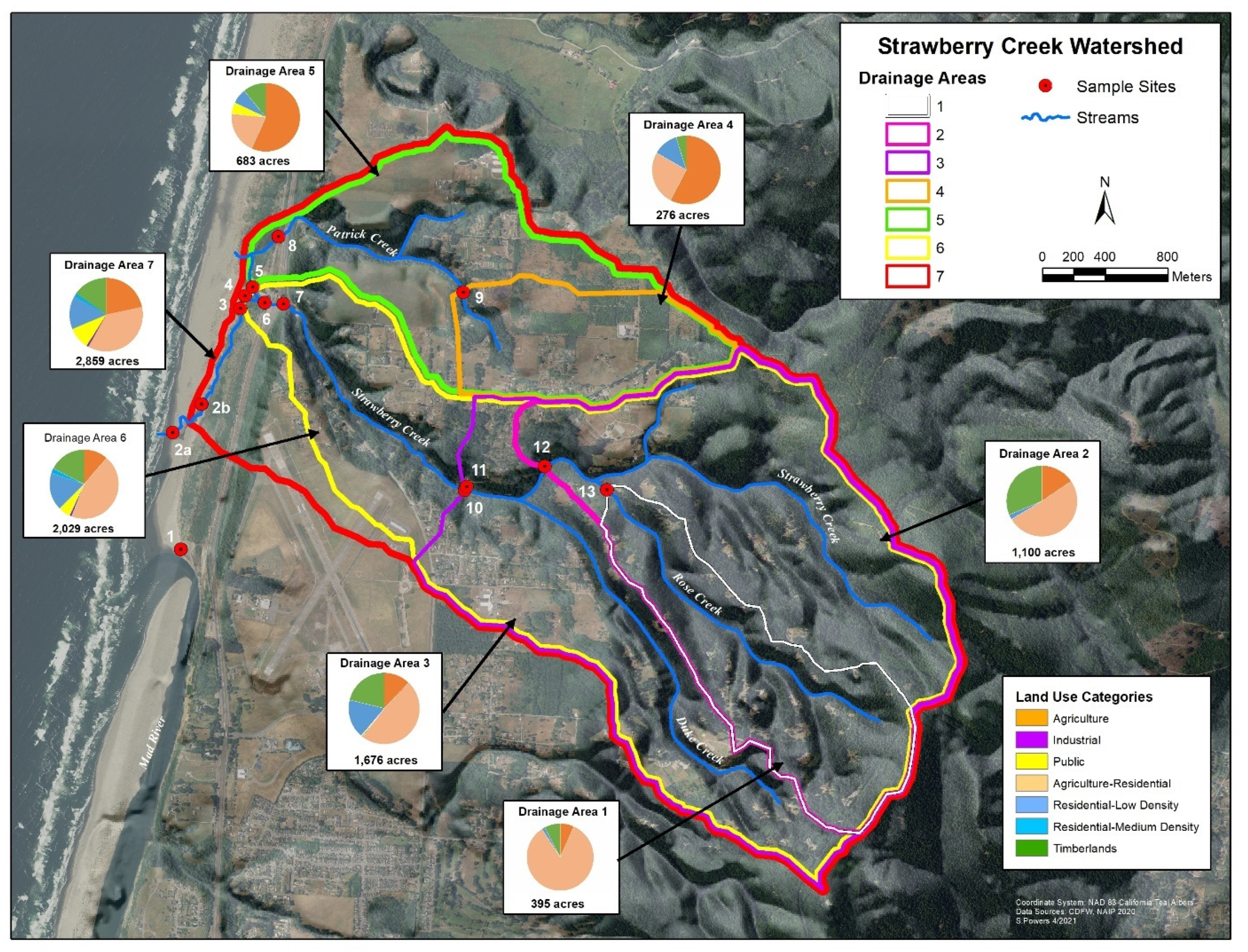
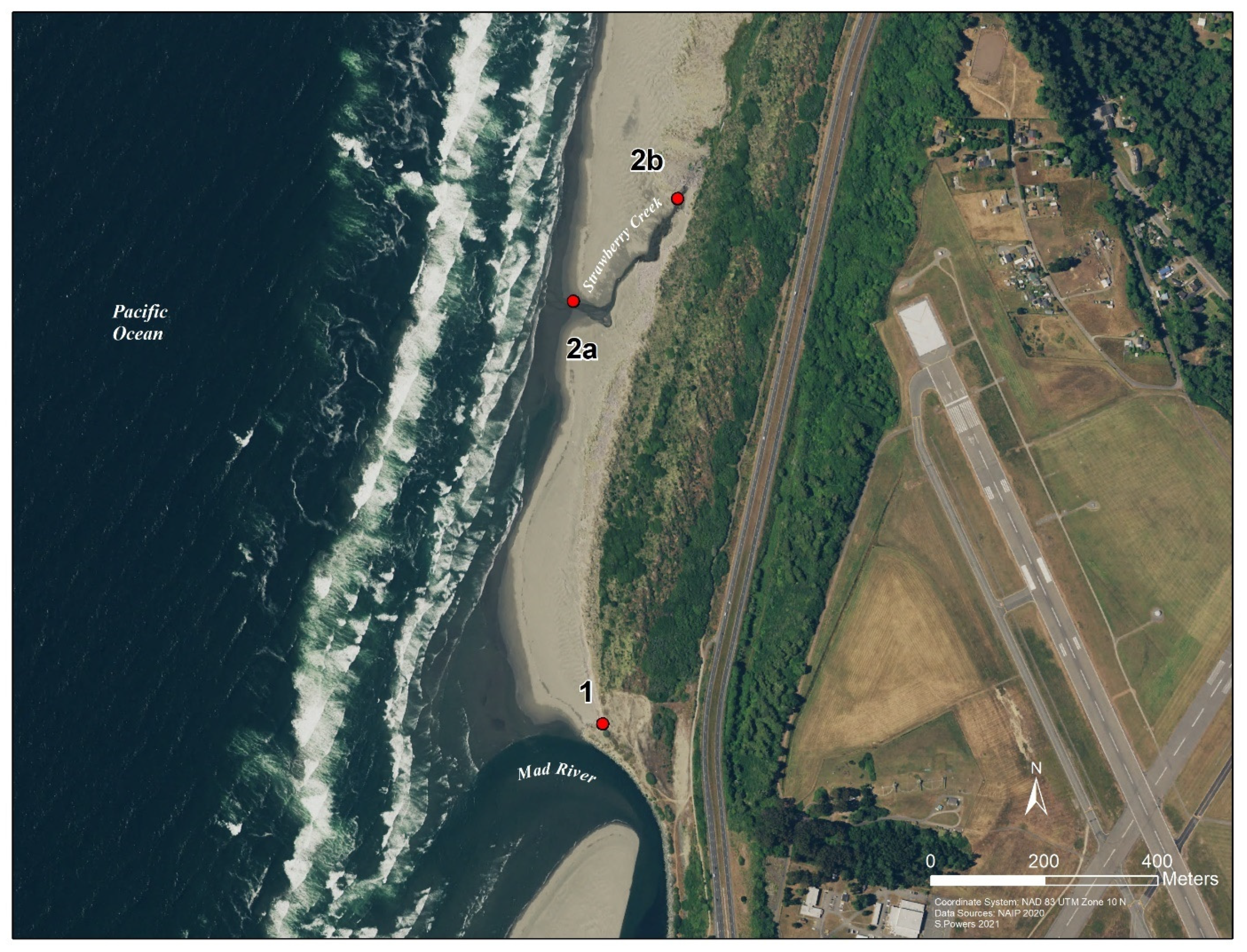
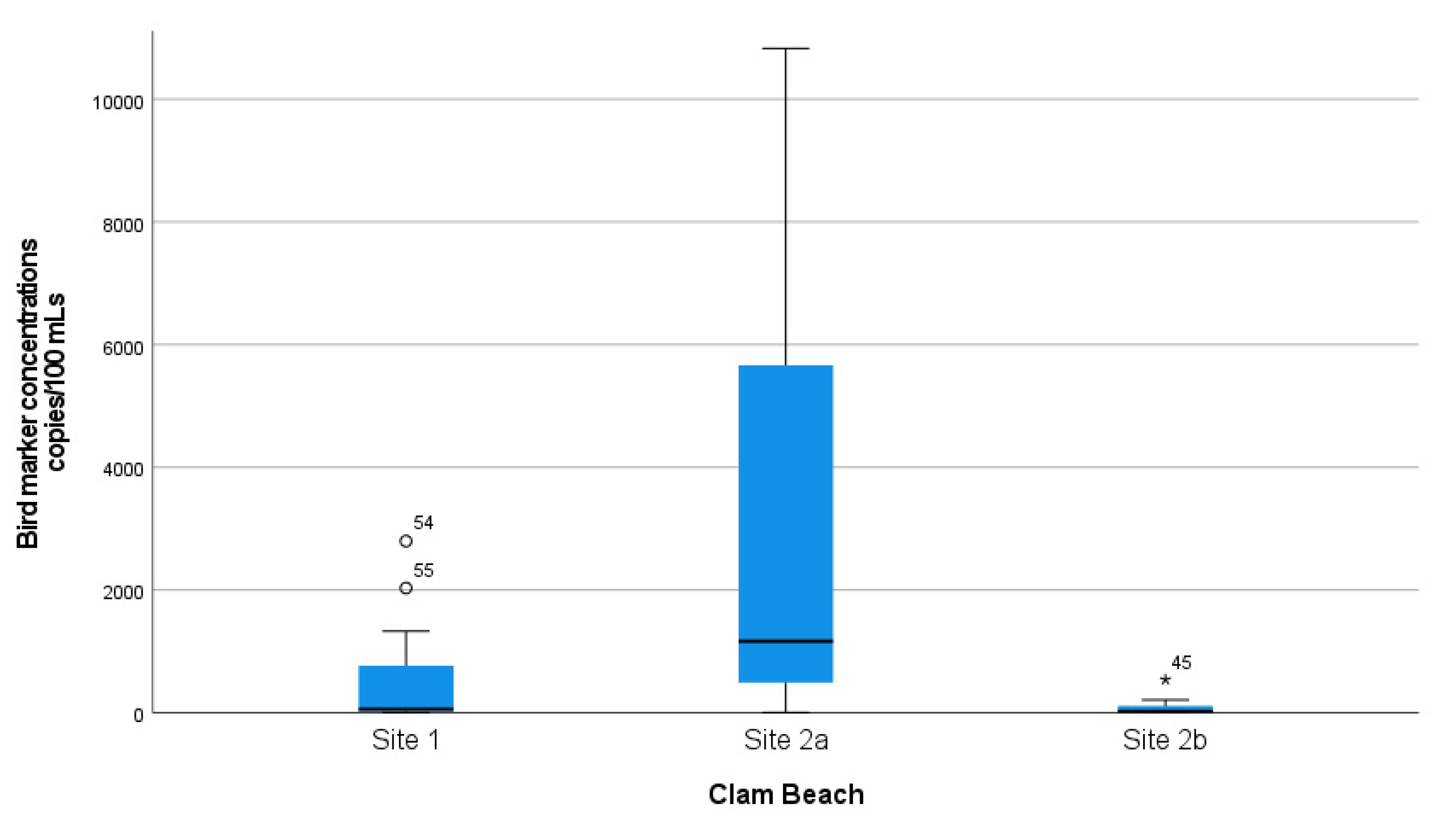
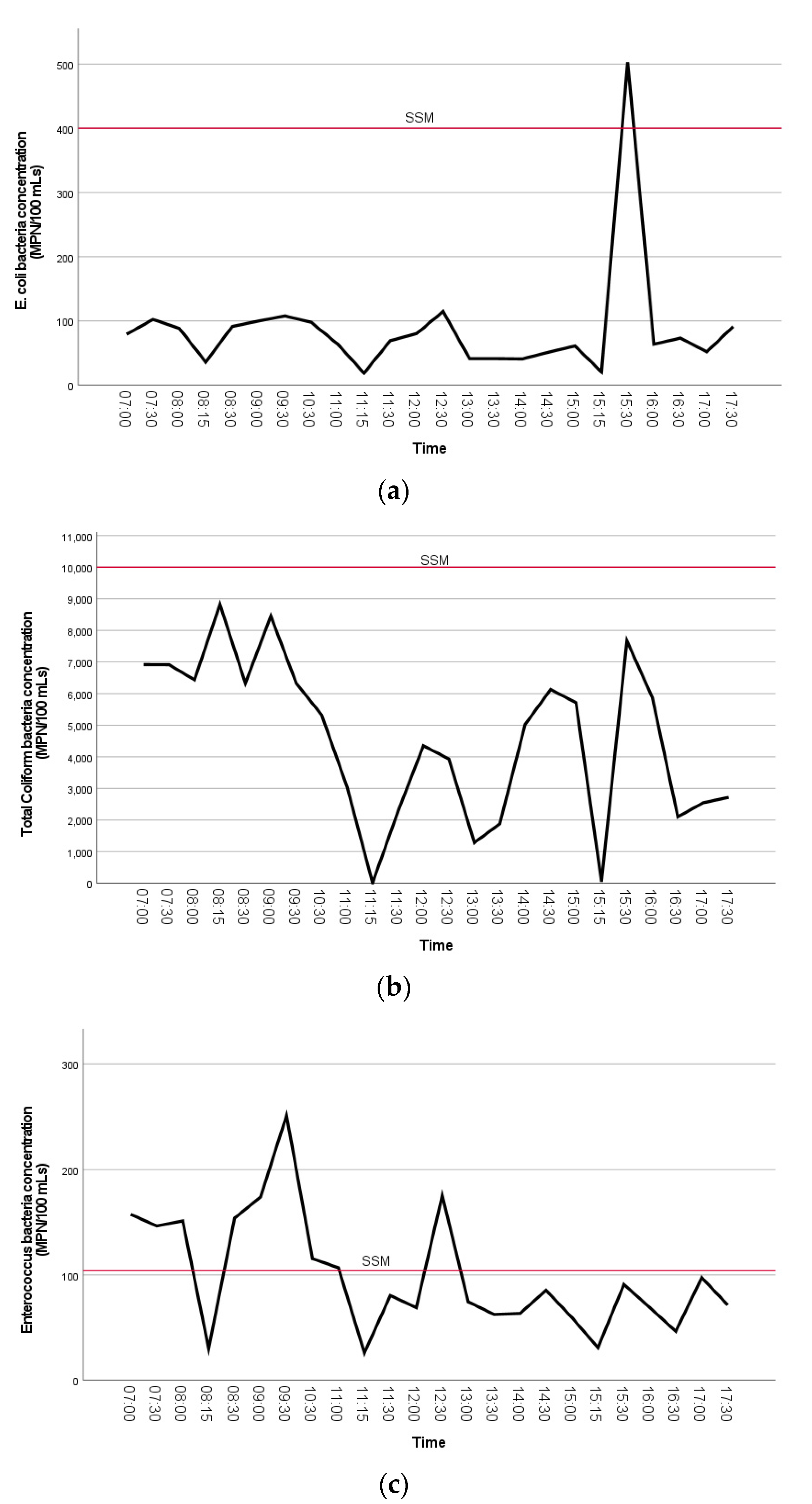
| Sample Results | Number and Percent of Animal-Host Markers | |||
|---|---|---|---|---|
| Human | Ruminant | Dog | Bird | |
| Not Detected | 54/54 (100%) | 54/54 (100%) | 48/54 (89%) | 21/54 (39%) |
| BLOQ a | 0/54 (0%) | 0/54 (0%) | 6/54 (11%) | 6/54 (11%) |
| Quantified | 0/54 (0%) | 0/54 (0%) | 0/54 (0%) | 27/54 (50%) |
| Sample Results | Number and Percent of Animal-Host Markers | |||
|---|---|---|---|---|
| Human | Ruminant | Dog | Bird | |
| Not Detected | 12/12 (100%) | 12/12 (100%) | 12/12 (100%) | 2/12 (17%) |
| BLOQ a | 0/12 (0%) | 0/12 (0%) | 0/12 (0%) | 6/12 (50%) |
| Quantified | 0/12 (0%) | 0/12 (0%) | 0/12 (0%) | 4/12 (33%) |
| Sample Results | Number and Percent of Animal-Host Markers | |||
|---|---|---|---|---|
| Human | Ruminant | Dog | Bird | |
| Not Detected | 131/135 (97%) | 94/135 (70%) | 128/135 (95%) | 128/135 (95%) |
| BLOQ a | 2/135 (1.5%) | 32/135 (24%) | 6/135 (4%) | 7/135 (5%) |
| Quantified | 2/135 (1.5%) | 9/135 (6%) | 1/135 (1%) | 0/135 (0%) |
Publisher’s Note: MDPI stays neutral with regard to jurisdictional claims in published maps and institutional affiliations. |
© 2021 by the authors. Licensee MDPI, Basel, Switzerland. This article is an open access article distributed under the terms and conditions of the Creative Commons Attribution (CC BY) license (https://creativecommons.org/licenses/by/4.0/).
Share and Cite
Corrigan, J.A.; Butkus, S.R.; Ferris, M.E.; Roberts, J.C. Microbial Source Tracking Approach to Investigate Fecal Waste at the Strawberry Creek Watershed and Clam Beach, California, USA. Int. J. Environ. Res. Public Health 2021, 18, 6901. https://doi.org/10.3390/ijerph18136901
Corrigan JA, Butkus SR, Ferris ME, Roberts JC. Microbial Source Tracking Approach to Investigate Fecal Waste at the Strawberry Creek Watershed and Clam Beach, California, USA. International Journal of Environmental Research and Public Health. 2021; 18(13):6901. https://doi.org/10.3390/ijerph18136901
Chicago/Turabian StyleCorrigan, Jeremy A., Steven R. Butkus, Michael E. Ferris, and Jill C. Roberts. 2021. "Microbial Source Tracking Approach to Investigate Fecal Waste at the Strawberry Creek Watershed and Clam Beach, California, USA" International Journal of Environmental Research and Public Health 18, no. 13: 6901. https://doi.org/10.3390/ijerph18136901
APA StyleCorrigan, J. A., Butkus, S. R., Ferris, M. E., & Roberts, J. C. (2021). Microbial Source Tracking Approach to Investigate Fecal Waste at the Strawberry Creek Watershed and Clam Beach, California, USA. International Journal of Environmental Research and Public Health, 18(13), 6901. https://doi.org/10.3390/ijerph18136901




